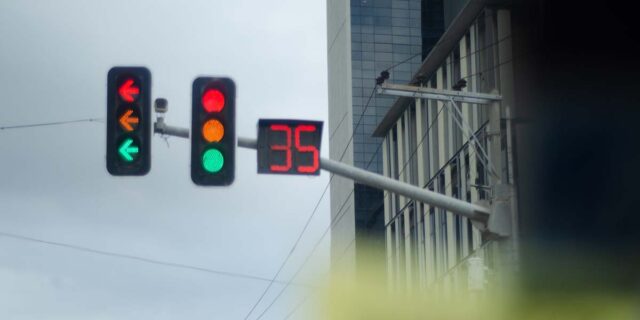The question “how big is a traffic light?” might not be the first question that comes to most drivers’ minds. But it won’t hurt to know a thing or two about this fantastic device.
Without traffic lights, the hold-ups and accidents on our roads will be unimaginable. Traffic light ensures the smooth movement of vehicles and pedestrians. They help to prevent accidents on daily basis and ensure commuters don’t waste time due to hold-ups.
So how big are the traffic lights you see hanging by the roadside?
Well, traffic lights look small when viewed above the ground. Traffic lights are usually raised 18 feet above the ground, where drivers can easily spot them, even from afar.
However, these spotlights aren’t as small as many of us think they are. One’s head might even fit into one of the cowls, surrounding each of the light.
In a nutshell, traffic lights are 4 feet tall, from top to bottom, or from any point you prefer to measure it.
Continue reading as we discuss more on the traffic light.
Traffic Light: Understanding The Different Colors
Knowing the various traffic light signals and meanings is crucial for drivers. You can’t claim you forgot or didn’t understand a signal light once you violate the law guiding traffic lights.
You’ll find three colored on most traffic lights.
One of the light signals is the green color. The green color indicates that you can continue past the intersection, as it’s safe.
A yellow light is also one of the lights you will find on this device. You can call it the “caution light.
When you come across a yellow light, keep in mind that the light is about to turn red, and you know what that means.
The yellow light is an indication that a driver needs to slow down and halt the vehicle or bike at the intersection.
As earlier indicated, the third light means that the vehicle or bike has to stop moving at the intersection.
In this case, you must wait for the green light to pop up before you drive through the intersection and continue your journey.
Every driver or road user is expected to understand the various traffic lights before putting their vehicles on the road.
Traffic lights are also positioned where drivers can easily spot them. And there are dare consequences for running a red light. Don’t forget that.
How Traffic Lights Function
You might spot two traffic lights at an intersection that looks almost similar but function in different ways.
The thing is the type of traffic light mounted at an intersection depends on how busy the intersection is.
In the urban regions where traffic congestion is an issue, the timer-based traffic light is commonly deployed.
In the timer traffic light, the signal light cycles between the green, yellow, and then red light, at a specific interval, to ensure proper flow of vehicles in different directions.
The timer traffic light isn’t the only traffic light in use. The intelligent or smart sensor-based traffic signal is another option.
This intelligent or smart traffic light is built to tackle the unique traffic situation in the rural areas, where traffic is usually very low. You can’t use the timer traffic light in these types of scenarios.
With the timer traffic light in a region with low traffic, drivers may be forced to wait unnecessarily, even when the road is free.
So, the sensor-based traffic light is a much better option in areas with low traffic. These types of traffic lights only get to work with there are heavy traffic.
Note – The sensor-based traffic light boasts various sensors or technology. That’s why they are called intelligent or smart traffic lights.
Some use hoses that come packed with air, laser, or cameras that help detect a vehicle’s presence on that portion of the road.
The inductive loop also happens to be another class sensor. It consists of a unique coil of wire, dug in the ground to help detect the presence of a vehicle or metal, standing still over the wire.
Can A Vehicle Change How Traffic Light Function?
Yes, and it is called traffic preemption. You will find such traffic lights in big cities and busy areas, though not every traffic light can be controlled.
Again, not every vehicle has the capability to change traffic. Only special vehicles made for such purpose can. Examples include police cars, ambulances, and even fire trucks.
You can’t expect the police vehicle to stop at traffic while chasing after robbers. Even the robbers won’t do the same thing. A fire truck responding to an emergency can influence the traffic light.
The Various Components Of Traffic A Light
Traffic lights have varied components, besides the green, yellow, and red lights they usually display.
So, here are the components below.
1. Light bulbs:
These are crucial component of the traffic light. Without light bulbs, there will be no traffic light.
So, what are the types of light bulbs used in traffic lights? Fortunately, there’s nothing special about them. They use the same light bulbs used in our home.
The reason for the varied colors projected by the spotlight is the result of the reflective casing.
This casing shines even brighter than the light bulb itself. Light passes through the varied reflective glass colors to deliver the yellow, green and red colors.
Again, you will find 100watts to 150-watts light bulbs on an incandescent traffic light, which can operate 24hours per day.
With these bulbs on 2.4 kilowatt-hours daily and 8 cents per kilowatt-hour, the electricity bill for one intersection could be as high as $600 per annum.
2. Controller:
Here you have one of the most vital components as far as the traffic signal is concerned. But in most cases, the controller isn’t visible to drivers.
One controller might be in charge of multiple intersections to ensure the proper flow of vehicular movement across the specific region.
So, the controller, which is similar to a “nerve center,” is one vital part of the traffic light you see at the intersection that you drive by now and then.
This part of the traffic light also boasts other sub-components. These include the detector card, logic rack, communication device (dial-up modern, for example), and finally, the software.
The software is there to ensure preemption of any public vehicle like that of the police, ambulances or fire trucks.
3. Lantern:
This component of the traffic signal is visible to drivers. The Lantern may come with a select type, assigned based on priority. It could be a lamp type, body type, and display type.
Check out other components of the traffic lights below.
4. Cabling:
These are usually buried underground and not visible to drivers.
5. Target boards:
The part where the lights and the reflective casing are mounted.
6. Pedestrian detectors/call boxes:
This component activates the pedestrian control device. It extends the crossing time when pedestrians land in the crosswalk and it shortens when pedestrians finally leave the crosswalk.
7. Poles
8. Poles attachments:
Examples are cameras.
Conclusion
So, how big is a traffic light? We hope you now understand how big traffic lights at various intersections are. In summary, different signal lights are mounted at intersections based on how busy the roads are.
Obeying traffic rules is the best thing to do while driving. This will prevent accident and ensure you don’t get into trouble in the hands of the police. So, drive safely and always obey traffic lights. We hope you found this post helpful. Thanks for stopping by.
You May Like These Articles As Well:














